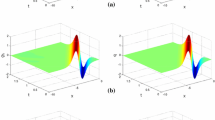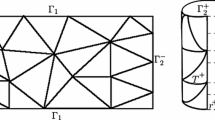Abstract
We propose the interpolatory hybridizable discontinuous Galerkin (Interpolatory HDG) method for a class of scalar parabolic semilinear PDEs. The Interpolatory HDG method uses an interpolation procedure to efficiently and accurately approximate the nonlinear term. This procedure avoids the numerical quadrature typically required for the assembly of the global matrix at each iteration in each time step, which is a computationally costly component of the standard HDG method for nonlinear PDEs. Furthermore, the Interpolatory HDG interpolation procedure yields simple explicit expressions for the nonlinear term and Jacobian matrix, which leads to a simple unified implementation for a variety of nonlinear PDEs. For a globally-Lipschitz nonlinearity, we prove that the Interpolatory HDG method does not result in a reduction of the order of convergence. We display 2D and 3D numerical experiments to demonstrate the performance of the method.
Similar content being viewed by others
References
Brenner, S.C., Scott, L.R.: The Mathematical Theory of Finite Element Methods, Texts in Applied Mathematics, vol. 15, 3rd edn. Springer, New York (2008). https://doi.org/10.1007/978-0-387-75934-0
Cesmelioglu, A., Cockburn, B., Qiu, W.: Analysis of a hybridizable discontinuous Galerkin method for the steady-state incompressible Navier–Stokes equations. Math. Comput. 86(306), 1643–1670 (2017). https://doi.org/10.1090/mcom/3195
Chabaud, B., Cockburn, B.: Uniform-in-time superconvergence of HDG methods for the heat equation. Math. Comput. 81(277), 107–129 (2012). https://doi.org/10.1090/S0025-5718-2011-02525-1
Chen, C.M., Larsson, S., Zhang, N.Y.: Error estimates of optimal order for finite element methods with interpolated coefficients for the nonlinear heat equation. IMA J. Numer. Anal. 9(4), 507–524 (1989). https://doi.org/10.1093/imanum/9.4.507
Chen, Z., Douglas Jr., J.: Approximation of coefficients in hybrid and mixed methods for nonlinear parabolic problems. Mat. Aplic. Comp. 10(2), 137–160 (1991)
Christie, I., Griffiths, D.F., Mitchell, A.R., Sanz-Serna, J.M.: Product approximation for nonlinear problems in the finite element method. IMA J. Numer. Anal. 1(3), 253–266 (1981)
Cockburn, B.: Static condensation, hybridization, and the devising of the HDG methods. In: Barrenechea, G., Brezzi, F., Cagniani, A., Georgoulis, E. (eds.) Building Bridges: Connections and Challenges in Modern Approaches to Numerical Partial Differential Equations, Lect. Notes Comput. Sci. Engrg., vol. 114, pp. 129–177. Springer, Berlin (2016). LMS Durham Symposia funded by the London Mathematical Society. Durham, U.K., on July 8–16 (2014)
Cockburn, B., Fu, G.: Superconvergence by \(M\)-decompositions. Part II: construction of two-dimensional finite elements. ESAIM Math. Model. Numer. Anal. 51(1), 165–186 (2017)
Cockburn, B., Fu, G.: Superconvergence by \(M\)-decompositions. Part III: construction of three-dimensional finite elements. ESAIM Math. Model. Numer. Anal. 51(1), 365–398 (2017)
Cockburn, B., Fu, G., Sayas, F.J.: Superconvergence by \(M\)-decompositions. Part I: general theory for HDG methods for diffusion. Math. Comput. 86(306), 1609–1641 (2017)
Cockburn, B., Gopalakrishnan, J., Lazarov, R.: Unified hybridization of discontinuous Galerkin, mixed, and continuous Galerkin methods for second order elliptic problems. SIAM J. Numer. Anal. 47(2), 1319–1365 (2009). https://doi.org/10.1137/070706616
Cockburn, B., Gopalakrishnan, J., Sayas, F.J.: A projection-based error analysis of HDG methods. Math. Comput. 79(271), 1351–1367 (2010). https://doi.org/10.1090/S0025-5718-10-02334-3
Cockburn, B., Shen, J.: A hybridizable discontinuous Galerkin method for the \(p\)-Laplacian. SIAM J. Sci. Comput. 38(1), A545–A566 (2016). https://doi.org/10.1137/15M1008014
Dickinson, B.T., Singler, J.R.: Nonlinear model reduction using group proper orthogonal decomposition. Int. J. Numer. Anal. Model. 7(2), 356–372 (2010)
Douglas Jr., J., Dupont, T.: The effect of interpolating the coefficients in nonlinear parabolic Galerkin procedures. Math. Comput. 20(130), 360–389 (1975)
Evans, L.C.: Partial Differential Equations, Graduate Studies in Mathematics, vol. 19, 2nd edn. American Mathematical Society, Providence (2010). https://doi.org/10.1090/gsm/019
Fletcher, C.A.J.: The group finite element formulation. Comput. Methods Appl. Mech. Eng. 37(2), 225–244 (1983). https://doi.org/10.1016/0045-7825(83)90122-6
Fletcher, C.A.J.: Time-splitting and the group finite element formulation. In: Computational Techniques and Applications: CTAC-83 (Sydney, 1983), pp. 517–532. North-Holland, Amsterdam (1984)
Gatica, G.N., Sequeira, F.A.: Analysis of an augmented HDG method for a class of quasi-Newtonian Stokes flows. J. Sci. Comput. 65(3), 1270–1308 (2015). https://doi.org/10.1007/s10915-015-0008-5
Kabaria, H., Lew, A.J., Cockburn, B.: A hybridizable discontinuous Galerkin formulation for non-linear elasticity. Comput. Methods Appl. Mech. Eng. 283, 303–329 (2015)
Kim, D., Park, E.J., Seo, B.: Two-scale product approximation for semilinear parabolic problems in mixed methods. J. Korean Math. Soc. 51(2), 267–288 (2014). https://doi.org/10.4134/JKMS.2014.51.2.267
Larsson, S., Thomée, V., Zhang, N.Y.: Interpolation of coefficients and transformation of the dependent variable in finite element methods for the nonlinear heat equation. Math. Methods Appl. Sci. 11(1), 105–124 (1989). https://doi.org/10.1002/mma.1670110108
López Marcos, J.C., Sanz-Serna, J.M.: Stability and convergence in numerical analysis. III. Linear investigation of nonlinear stability. IMA J. Numer. Anal. 8(1), 71–84 (1988)
Moro, DaCN, Peraire, J.: A hybridized discontinuous Petrov–Galerkin scheme for scalar conservation laws. Int. J. Numer. Methods Eng. 91, 950–970 (2012)
Nguyen, N.C., Peraire, J.: Hybridizable discontinuous Galerkin methods for partial differential equations in continuum mechanics. J. Comput. Phys. 231, 5955–5988 (2012)
Nguyen, N.C., Peraire, J., Cockburn, B.: An implicit high-order hybridizable discontinuous Galerkin method for nonlinear convection–diffusion equations. J. Comput. Phys. 228(23), 8841–8855 (2009). https://doi.org/10.1016/j.jcp.2009.08.030
Nguyen, N.C., Peraire, J., Cockburn, B.: A hybridizable discontinuous Galerkin method for the incompressible Navier–Stokes equations (AIAA Paper 2010-362). In: Proceedings of the 48th AIAA Aerospace Sciences Meeting and Exhibit. Orlando, Florida (2010)
Nguyen, N.C., Peraire, J., Cockburn, B.: An implicit high-order hybridizable discontinuous Galerkin method for the incompressible Navier–Stokes equations. J. Comput. Phys. 230(4), 1147–1170 (2011). https://doi.org/10.1016/j.jcp.2010.10.032
Nguyen, N.C., Peraire, J., Cockburn, B.: A class of embedded discontinuous Galerkin methods for computational fluid dynamics. J. Comput. Phys. 302, 674–692 (2015)
Peraire, J., Nguyen, N.C., Cockburn, B.: A hybridizable discontinuous Galerkin method for the compressible Euler and Navier–Stokes equations (AIAA Paper 2010-363). In: Proceedings of the 48th AIAA Aerospace Sciences Meeting and Exhibit. Orlando, Florida (2010)
Rivière, B.: Discontinuous Galerkin methods for solving elliptic and parabolic equations: theory and implementation. In: Frontiers in Applied Mathematics, vol. 35. Society for Industrial and Applied Mathematics (SIAM), Philadelphia (2008). https://doi.org/10.1137/1.9780898717440
Sanz-Serna, J.M., Abia, L.: Interpolation of the coefficients in nonlinear elliptic Galerkin procedures. SIAM J. Numer. Anal. 21(1), 77–83 (1984). https://doi.org/10.1137/0721004
Tourigny, Y.: Product approximation for nonlinear Klein–Gordon equations. IMA J. Numer. Anal. 10(3), 449–462 (1990). https://doi.org/10.1093/imanum/10.3.449
Ueckermann, M.P., Lermusiaux, P.F.J.: Hybridizable discontinuous Galerkin projection methods for Navier–Stokes and Boussinesq equations. J. Comput. Phys. 306, 390–421 (2016). https://doi.org/10.1016/j.jcp.2015.11.028
Wang, C.: Convergence of the interpolated coefficient finite element method for the two-dimensional elliptic sine-Gordon equations. Numer. Methods Partial Differ. Equ. 27(2), 387–398 (2011). https://doi.org/10.1002/num.20526
Wang, Z.: Nonlinear model reduction based on the finite element method with interpolated coefficients: semilinear parabolic equations. Numer. Methods Partial Differ. Equ. 31(6), 1713–1741 (2015). https://doi.org/10.1002/num.21961
Xie, Z., Chen, C.: The interpolated coefficient FEM and its application in computing the multiple solutions of semilinear elliptic problems. Int. J. Numer. Anal. Model. 2(1), 97–106 (2005)
Xiong, Z., Chen, C.: Superconvergence of rectangular finite element with interpolated coefficients for semilinear elliptic problem. Appl. Math. Comput. 181(2), 1577–1584 (2006). https://doi.org/10.1016/j.amc.2006.02.040
Xiong, Z., Chen, C.: Superconvergence of triangular quadratic finite element with interpolated coefficients for semilinear parabolic equation. Appl. Math. Comput. 184(2), 901–907 (2007). https://doi.org/10.1016/j.amc.2006.05.192
Xiong, Z., Chen, Y., Zhang, Y.: Convergence of FEM with interpolated coefficients for semilinear hyperbolic equation. J. Comput. Appl. Math. 214(1), 313–317 (2008). https://doi.org/10.1016/j.cam.2007.02.023
Acknowledgements
J. Singler and Y. Zhang were supported in part by National Science Foundation Grant DMS-1217122. J. Singler and Y. Zhang thank the IMA for funding research visits, during which some of this work was completed. Y. Zhang thanks Zhu Wang for many valuable conversations.
Author information
Authors and Affiliations
Corresponding author
Ethics declarations
Conflict of interest
The authors declare that they have no conflict of interest.
Additional information
Publisher's Note
Springer Nature remains neutral with regard to jurisdictional claims in published maps and institutional affiliations.
Implementation Details for General Nonlinearities
Implementation Details for General Nonlinearities
1.1 The Interpolatory HDG Formulation
The full Interpolatory HDG discretization is to find \((\varvec{q}^n_h,u^n_h,\widehat{u}^n_h)\in \varvec{V}_h\times W_h\times M_h\) such that
for all \((\varvec{r},w,\mu )\in \varvec{V}_h\times W_h\times M_h\) and \(n=1,2,\ldots ,N\). Similar to Sect. 3.2, we have
where
Then the system (45) can be rewritten as
i.e., \( M\varvec{x}_n + {\mathscr {F}}(\varvec{x}_n) = \varvec{b}_n \).
Newton’s method proceeds as in Sect. 3.2, but the Jacobian matrix \(G'(\varvec{x}_n^{(m-1)})\) is now given by
where for \( k = 1, 2, 3, \) we define
and \(F_k'\) denotes the partial derivative of F with respect to the kth variable. Therefore, the linear system that must be solved is now given by
where
1.2 Local Solver
The system (49) can be rewritten as
where \(\varvec{x}=[\varvec{\alpha ^{n,(m)}};\varvec{\beta ^{n,(m)}}]\), \(\varvec{y}=\varvec{\gamma }^{n,(m)}\), \(\varvec{z}=\varvec{\zeta }^{n,(m)}\), \( {\widetilde{\varvec{b}}} = [ b_1;b_2;b_3] \), and \(\{B_i\}_{i=1}^7\) are the corresponding blocks of the coefficient matrix in (49). The system (51) is equivalent with following equations:
Similar to before, the matrices \(B_1\) and \(B_5\) are block diagonal with small blocks and they can be easily inverted. Use (52a) and (52b) to express \(\varvec{x}\) and \(\varvec{y}\) in terms of \(\varvec{z}\) as follows:
where
As in Sect. 3.3, the matrix Q is block diagonal with small blocks. Since \(A_1\) is positive definite, if \(\varDelta t\) is small enough then Q is easily inverted. Then we insert \(\varvec{x}\) and \(\varvec{y}\) into (26c) and obtain the final system only involving \(\varvec{z}\):
Rights and permissions
About this article
Cite this article
Cockburn, B., Singler, J.R. & Zhang, Y. Interpolatory HDG Method for Parabolic Semilinear PDEs. J Sci Comput 79, 1777–1800 (2019). https://doi.org/10.1007/s10915-019-00911-8
Received:
Revised:
Accepted:
Published:
Issue Date:
DOI: https://doi.org/10.1007/s10915-019-00911-8




